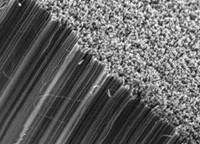 |
| The small carbon tubes have been shown to retain the gas for at least six months. |
A team of scientists at ANSTO has made and filled the worlds smallest gas cylinders - about 25,000 of which would fit side by side on the head of a pin.
The work of the team, which researches new materials with the potential to benefit industry, was published in Science, the prestigious journal of the American Association for the Advancement of Science.
The gas cylinders, very small carbon fibre tubes with inner diameters as small as 10 nanometres (one 100th of a millionth of a metre) may have uses in biomedical research and industrial applications.
The ANSTO team, led by senior research scientist, Dr Gerry Gadd, sealed the rare gas argon in the tubes at a pressure of 600 times normal atmosphere. The empty tubes, sealed at each end, were heated at this pressure in an atmosphere of argon. On examining them with an electron microscope, it was found the gas had become trapped in their hollow centres.
"Imagine a roll of carpet with sealed ends," Dr Gadd said. "The gas reaches the hollow middle by entering under the outside edge of the carpet and passes around until it reaches the centre. Finally, the outer edge of the carpet is changed by the effects of temperature - and this stops the gas escaping."
The small carbon tubes have been shown to retain the gas for at least six months. Dr Gadd said ANSTO would be examining potential applications for the discovery.
"The tubes could have applications in industrial and medical imaging. They could be filled with rare gas and then irradiated to produce a radioisotope aimed, for example, at a specific organ of the body," he said.
"As the behaviour of these tubes will be different from hollow tubes, there may be new properties for carbon fibre composite materials. They may also be useful as temperature or pressure sensors in nanotechnology," Dr Gadd said.
The research at ANSTO was a collaboration between its Materials and Physics Divisions. The team of physicists, chemists and technical staff consisted of Dr Gadd, Mark Blackford, Sam Moricca, Neil Webb, Dr Peter Evans, Dr Andrew Smith, Dr Geraldine Jacobsen, Sammy Leung, Dr Arthur Day and Quan Hua.
To advance the research, the next task is to make the tubes in bulk, enough to fill a teaspoon. For those who need to know how many this will require, Gerry Gadd estimates about 1,000,000,000,000 - depending on how they line up in the bowl of the spoon.


